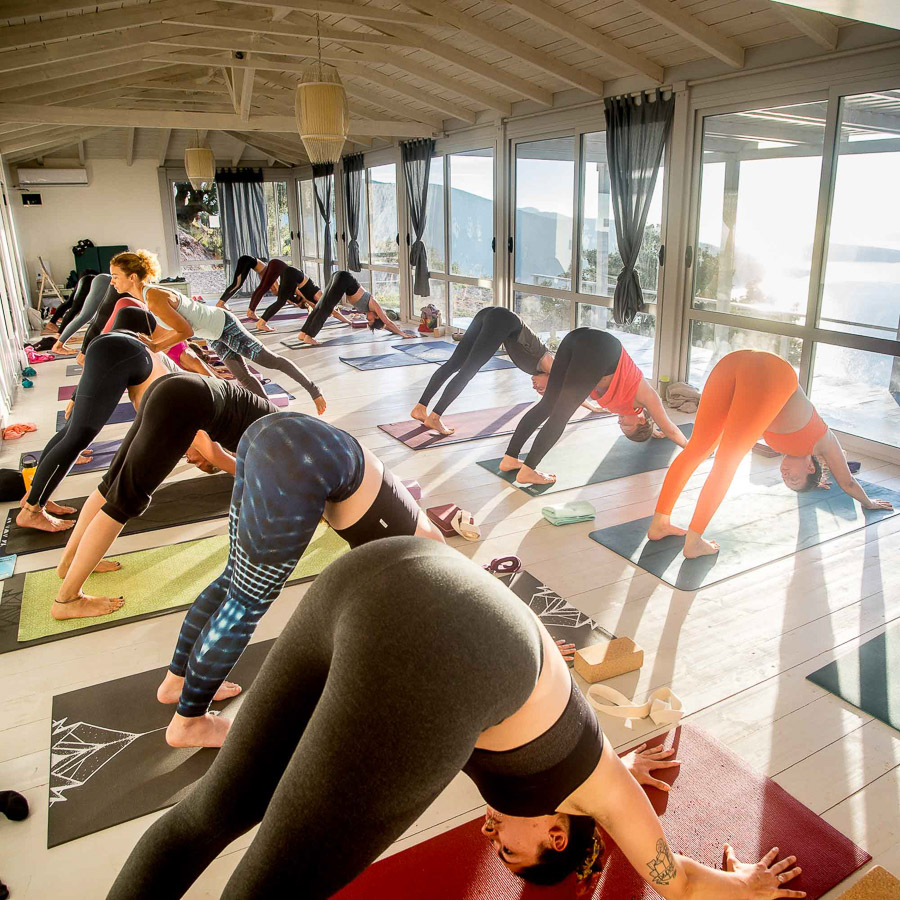In this blog post, we break down the 6 most important reasons to start and sustain an Ashtanga practice.
In this article:
Ashtanga Vinyasa Yoga is a system of yoga that was brought to the modern world by yogi Sri K. Pattabhi Jois. There are several series included within an Ashtanga practice, starting with the primary series and increasing in difficulty as you progress through the series. It is a fast-paced, physically challenging practice with a set sequence of asanas, offered in most studios both guided and Mysore-style (where a student is able to move at their own pace, assessed by experienced Ashtanga teachers).
1. First reason to start and sustain an Ashtanga practice: Win the morning, win the day!
Ashtangis tend to be (or at least soon become) early risers. There is an unparalleled level of satisfaction that comes from completing the primary series, particularly before most of your friends are even awake.
The early bird gets the worm. The Yogi who, by 8 am, has completed a 90-minute practice can breeze through the rest of the day. The qualities cultivated in the practice such as strength, steadiness, and flexibility (in body and mind) are carried through the rest of the day.
“But I am so stiff in the morning! Is Ashtanga for me?” Aren’t we all stiff?
Friendly reminder, Yoga is more than physical poses. Practicing early is great for the mind, though practicing later may feel better for the body. A deeper pose doesn’t necessarily equate to a more rewarding practice.
Morning for the mind. Afternoon for the body.

2. Second reason to start and sustain an Ashtanga practice: Mastery is reached only through repetition
A second reason to start and sustain an Ashtanga practice:
Variation might just be the spice of life but you can’t live off spices alone. Where is the (impossible) met? We need substance. Consistency, not variety.
6 days a week. 52 weeks a year you do the same sequence. To some, this sounds monotonous, even torturous. Interestingly, despite following the same sequence, no two practices ever feel the same, familiar yes, but always different.
The practice provides a constant in an otherwise chaotic world. It doesn’t succumb to fleeting trends in the Yoga world. It is dependable. When everything else in your life is changing around you, the practice remains the same.
Novelty is undeniably exciting. Our brain is primed to notice “new” things. Social media forces us to constantly be on the lookout for the next thing. Remember, curiosity killed the cat but it was satisfaction that brought it back. The key to satisfaction is depth, which can only be achieved through repetition.
Spices can’t satiate you. They can (momentarily) entertain your taste buds but they can’t sustain you. An Ashtanga Practice is the substance of your Yoga practice. You can explore other flavors (aka styles of Yoga) with the comfort that your body already has what it needs.
There is nothing worse than choosing what to eat when you are hungry. Instead of chasing fad diets (aka Yoga styles) stay consistent. Your body will thank you.
Don’t starve your body of what it needs. Feed it something substantial. Feed it with an Ashtanga practice. Anything extra is a bonus.
You might also like to read about 9 yoga styles explained in detail

3. Third reason to start and sustain Ashtanga practice: Balance of static and dynamic
Ashtanga is a time-tested sequence. Exactly how much time is up for debate but it has certainly been around longer than other modern styles of Yoga. It strikes the balance between movement and stillness, Yang and Yin, dynamic and static.
Sun Salutations as the warm-up
Straight out of the gate the practice begins with the Surya Namaskar, salutations to the sun. The student moves in a dynamic fashion, one-movement-one-breath. As the same suggests this serves to build heat in the body and set the cadence for the rest of the practice.
5 sun salutation A’s, the Yogic equivalent of a burpee, is how the practice starts. Each salutation consists of 14 breaths. We take 9 movements while the body moves, and 5 breaths when the body is remaining still in downward facing dog.
Standing postures or otherwise called Fundamental Postures
The dynamic salutations are followed by the standing series, a combination of poses, each held for 5 breaths. This is fast enough to keep the heat but long enough to experience the details and benefits of the pose. Some modern vinyasa classes are so quick that by the time you have even noticed that your knee is out of alignment you are already three poses behind.
Seated Postures (they depend on the series)
After the standing poses come the seated series, poses that focus on twisting the spine, opening the hips, and lengthening the posterior (back) side of the body.
The Finishing Sequence (same in every series)
The practice ends with inversions, which are held longer than the usual five breaths, to elicit a calming and grounding state in preparation for savasana, the final rest.
Some would argue that the primary series (the first of six) is disproportionately focused on forward folding, formally known as hip and spinal flexion.
In our 200-hour yoga teacher training, we use the Ashtanga Yoga method so that students can deepen their practice, learn how to self-practice, and stop depending on other studios/yoga teachers and expensive memberships.
You might also like: How to choose the right Yoga Training for you

4. Forth reason to practice Ashtanga Yoga: CommUnity
Ashtanga is a global practice. The sequences are practiced in the same way EVERYWHERE.
There is a sense of camaraderie that I haven’t experienced in any other style of Yoga. Comparable to the energy of marathon runners, though they are all moving at different speeds, they are working toward the same goal.
Different members of an orchestra. Moving together.
On a local scale, you build a community with those you practice alongside. Though you may be at different levels. Students may offer advice and encouragement since they too have been there.
The Ashtanga practice becomes less about the teacher. In a vinyasa class, you come and follow the instructions of the teacher since the sequence can be literally anything.
Synchronized. Since people move through the practice. Mysore-style (the birthplace of Ashtanga) is the self-practice under the guidance of an experienced teacher who moves around the room, giving you individualized assistance. Rather than teaching to average.
Connection – mind, body breath. Simplicity. Tristana.
9 Important Tips to Know Before Choosing Any Yoga Teacher Training.
5. Fifth reason to sustain an Ashtanga practice: Autonomy (Autonomous Ashtangis)
Choosing to go to and needing to go to a Yoga class are two very different things. A chef may have someone else to cook for them, but they don’t need them to. It is a choice, not a necessity. It is appreciated but not required.
Modern society has a tendency to delegate. We outsource cleaning the house, cooking our meals, and, in some cases, raising our children. Delegation isn’t bad. It is usually a matter of time management and efficiency.
In the same way, an Ashtanga practitioner may choose to attend a Yoga class despite having the ability to practice independently, without a teacher.
However, is your spiritual life really something to be delegated? Does the responsibility of your physical/mental body lie with someone else?
We easily fall into the role of ‘care receiver’ expecting parents, teachers, and coaches to take charge. This one-directional transaction can only take us so far.
An Ashtanga practitioner takes an active role in their Yoga journey. Rather than blindly following a teacher, the Ashtangi (excuse the cliche) listens to the teacher within, aka themselves.
An Ashtanga student can choose to practice in three main ways.
- Firstly, they can practice at home, independent of a teacher.
- Secondly, they self-practice, alongside others, assisted by a teacher, in a so-called Mysore class.
- Finally, they can attend an Ashtanga-led class, usually taught once a week, on a Friday or Saturday, depending on the studio.
In a typical Yoga class students follow, somewhat passively, the instructions of the teacher. An Ashtangi develops self-sufficiency. They try, fail, and then learn from their failures. These failures are the gateway to learning, not just inevitable but essential.
Self-practice in Yoga, much like self-study in education, is what sets students apart. Progress will still occur without it, but much slower. An Ashtangi takes accountability for their own success and failures.
Anytime, anywhere
How much time do you spend looking for a class at a time that fits your schedule?
By taking your practice into your own hands (or home) you no longer need to worry about logistics. You practice when and where works for you.
For those who do want to practice Ashtanga in a studio, the timings are (almost) universal. Check the schedule of any Yoga studio, anywhere in the world and I guarantee that the Mysore class will be at 6 am or 8 am daily, excluding Saturday. The Ashtanga Led class, either on Friday or Saturday, will be around 8 am.
This consistency streamlines the process and allows you, wherever you are in the world, to stick to your practice. Consistency is key.
Less fuss, more yoga
An Ashtanga student can roll out of bed, roll out their mat and begin their practice. Zero travel time. No rushing to catch a bus, train, or metro.
The Ashtangi is not only more efficient but also more effective. Why? If Yoga is about stilling the mind and aligning the body, then everything else detracts from the purpose. Booking, attending, and commuting to (and from) a Yoga class takes time, effort, and money.
It is true that many Ashtanga students choose to practice at a studio, Mysore style. Even this mode of practice is minimalistic, refined with minimum fuss. The class starts and ends the same way, at the same time, six days a week.
Mysore class is devoid of distraction. No music. Rarely props (blocks, bolsters and straps). Besides the opening and closing chant, the room is almost silent. The only thing that can be heard is the oceanic sound of ujjayi breath. Just you and your breath.

6. The last but not the least reason to start and sustain an Ashtanga practice: Challenge
The body needs repetition but the mind craves variety. The brain is literally programmed to be on the lookout for new information. In modern life, this manifests in the following fashion: hunting for new restaurants and exotic locations. Ashtanga avoids trends. The sequence does not change based on whichever hashtag yoga pose is trending.
In the first 3-6 months of an Ashtanga practice, the student’s skill level rockets. Much like a relationship, the first 6-months are golden. However, after this, as is the case with most things, progress slows. Things start to feel ‘samey’. At this point, many students give up, and relationships end. But anyone who has pushed through the plateau knows what is on the other side is worth it.
Every time you practice, though the sequence is the same, challenge yourself to spot something different. Pay more attention to a particular component. It could be the breath, the Drishti (looking place), trying to find more ease or more strength. Notice the nuance.
In our 200hours yoga teacher training, we will teach you the Ashtanga method so that you can have a strong self-practice, independent of yoga teachers and memberships. You will also learn Vinyasa yoga, so you can maximize yoga career opportunities as a yoga teacher.






Really liked your content and information, got to learn alot from your blog. Will surely going to implement this useful information on my website